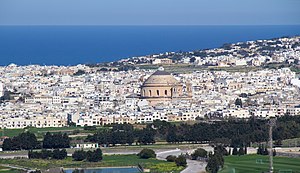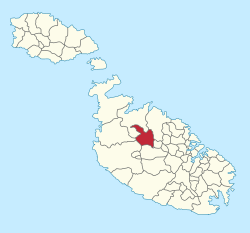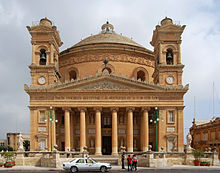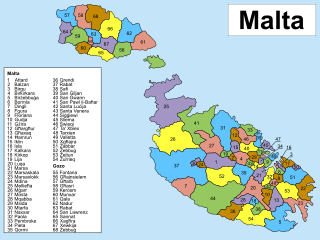
Since June 30, 1993, Malta has been subdivided into 68 localities, governed by local councils, Maltese: kunsilli lokali, meaning municipalities or borough, and the considered by the Maltese as the equivalent to a basic village or towns, where appropriate. These form the most basic form of local government and there are no intermediate levels between it and the national level. The levels of the 6 districts and of the 5 regions serve statistical purposes.
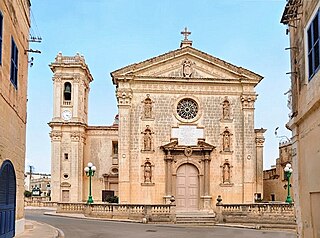
Attard is a town in the Central Region of Malta. Together with Balzan and Lija it forms part of "the Three Villages" and has been inhabited since the Classical Period. It has a population of 12,268 as of 2021. Attard's traditional Latin motto is Florigera rosis halo due to its many flower gardens and citrus orchards. Attard is abundant with public gardens. The inhabitants of Attard are known as saraċini.

Mġarr, formerly known as Mgiarro, is a village in the Northern Region of Malta. Mġarr is a typical rural village situated in an isolated region, west of Mosta. It is surrounded with rich farmland and vineyards. Many of its 4,840 inhabitants are farmers or are engaged in some sort of agricultural activity. Maltese pop singers Christabelle Borg and Gaia Cauchi both hail from this town.

Birkirkara is a city in the central region of Malta. It is the second most populous on the island, with 24,356 inhabitants as of 2020. The town consists of five autonomous parishes: Saint Helen, Saint Joseph the Worker, Our Lady of Mount Carmel, Saint Mary and San Gorg Preca. The city's motto is In hoc signo vinces, and its coat of arms is a plain red cross, surmounted by a crown.
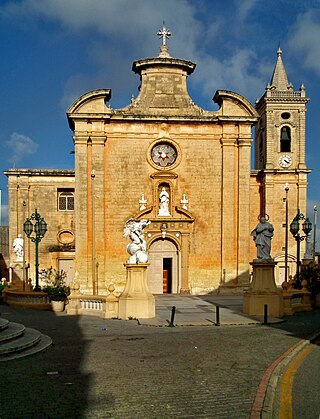
Balzan is a municipality in the Central Region of Malta, one of the so-called three villages, together with Attard and Lija. The village originally consisted of a group of small dwellings and farms but eventually grew, becoming a parish in the 17th century. As of 2021, the town registered a population of 4,774 inhabitants.

Siġġiewi, also called by its title Città Ferdinand, is a city and a local council in the Southern Region of Malta. It is the third largest council in Malta by surface area, after Rabat and Mellieħa. It is situated on a plateau, a few kilometers away from Mdina, the ancient capital city of Malta, and 10 kilometres away from Valletta, the contemporary capital. It is the home of 8,721 inhabitants as of January 2019. Until several decades ago, almost all of the population was employed in the fields which surround the city. In 1993, the city adopted the motto Labore et Virtute.

Rabat is a town in the Northern Region of Malta, with a population of 11,497 as of March 2014. It adjoins the ancient capital city of Mdina, and a north-western area formed part of the Roman city of Melite until its medieval retrenchment. The Apostolic Nunciature of the Holy See to the Republic of Malta is seated in this village. The Local Council of Rabat is also the administrator of Baħrija. Parts of the films Munich and Black Eagle were shot in Rabat. In December 1999, Mtarfa was split from Rabat to form a separate Local Council by Act XXI, an amendment to the Local Council Act of 1993.

The Sanctuary Basilica of the Assumption of Our Lady, commonly known as the Rotunda of Mosta or the Mosta Dome, is a Roman Catholic parish church and basilica in Mosta, Malta, dedicated to the Assumption of Mary. It was built between 1833 and the 1860s to neoclassical designs of Giorgio Grognet de Vassé, on the site of an earlier Renaissance church which had been built in around 1614 to designs of Tommaso Dingli.

Żurrieq is a town in the Southern Region of Malta. It is one of the oldest towns in the country, and it has a population of 11,823 inhabitants as of March 2014. Żurrieq is one of the 10 parishes to be documented in 1436 and it is dedicated to Saint Catherine. The island of Filfla is administratively a part of the town. The town stretches from Nigret to Ħal Far. In old times the town was had a border with Żejtun. The village of Qrendi used to be part of the parish of Żurrieq until 1618 when it was made into its own parish.

Gudja is a village in the Southern Region of Malta, with a population of 3,148 as of March 2017. The village is located on high grounds, south of Valletta. It is administered by the Gudja Local Council. A number of schools, clubs, public gardens and recreations places are found around the village.

Qrendi is a village in the Southern Region of Malta, with a population of 2752 people as of March 2014. It is located close to Mqabba, Żurrieq and Siggiewi. Within its boundaries are two well-known Neolithic temples called Mnajdra and Ħaġar Qim. In this village two feasts are held annually. The feast of Our Lady of Lourdes is celebrated either on the last Sunday of June or on the first Sunday of July, with 15 August the titular feast of the Ascension of Our Lady. This feast is popularly known as the feast of Santa Maria.
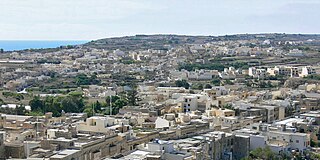
Ta' Kerċem is an administrative unit of Malta, on the island of Gozo, with a population of 1,938 people as of March 2014.

Bidnija is a rural hamlet between Mosta, St. Paul's Bay and Mġarr. It is located in the northern region of Malta and is home to roughly 308 people as of 2008, the second least populated habitable zone on the Maltese islands after Mdina. It is located between two main valleys then extends into other small valleys surrounding the area. It is largely a rural village surrounded by fields mainly belong to the inhabitants, although over the years other Maltese and foreigners have settled in the area generally for its countryside views.

In Malta most of the main roads are in the outskirts of the localities to connect one urban area with another urban area. The most important roads are those that connect the south of the island with the northern part, like Tal-Barrani Road, Aldo Moro Street in Marsa and Birkirkara Bypass.

There are hundreds of catacombs in Malta, principally found in Mdina, the former capital of the island. The catacombs are very small, but are in good preservation.

Fort Mosta is a polygonal fort in Mosta, Malta. It was built between 1878 and the 1880s by the British as part of the Victoria Lines. It is still in use today by the Armed Forces of Malta as an ammunition depot.

Chadwick are a number of dams, pouring into each other, on the island of Malta. The area is locally known as Wied il-Qlejgħa. Their location extends from Qliegħa Valley in the limits of Mtarfa and Rabat, and extends to Għasel Valley in the peripheries of Mosta. It consists of a complex system of well-planned small dams, draining into Speranza Valley, then at Salina Bay, and then into the sea.

The Cumbo Tower is a villa in the town of Mosta which served as a stronghold during its time. The tower is a two-storey building adorned with a niche on the main façade and surrounded by extensive gardens.

The Chapel of St. Paul the Hermit is a small church located in a cave in Wied il-Għasel, in Mosta, Malta.
